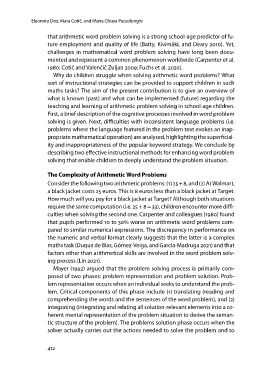Page 412 - Istenič Andreja, Gačnik Mateja, Horvat Barbara, Kukanja Gabrijelčič Mojca, Kiswarday Vanja Riccarda, Lebeničnik Maja, Mezgec Maja, Volk Marina. Ur. 2023. Vzgoja in izobraževanje med preteklostjo in prihodnostjo. Koper: Založba Univerze na Primorskem
P. 412
onora Doz, Mara Cotič, and Maria Chiara Passolunghi
that arithmetic word problem solving is a strong school-age predictor of fu-
ture employment and quality of life (Batty, Kivimäki, and Deary 2010). Yet,
challenges in mathematical word problem solving have long been docu-
mented and represent a common phenomenon worldwide (Carpenter et al.
1980; Cotič and Valenčič Zuljan 2009; Fuchs et al. 2020).
Why do children struggle when solving arithmetic word problems? What
sort of instructional strategies can be provided to support children in such
maths tasks? The aim of the present contribution is to give an overview of
what is known (past) and what can be implemented (future) regarding the
teaching and learning of arithmetic problem solving in school-age children.
First, a brief description of the cognitive processes involved in word problem
solving is given. Next, difficulties with inconsistent language problems (i.e.
problems where the language featured in the problem text evokes an inap-
propriate mathematical operation) are analysed, highlighting the superficial-
ity and inappropriateness of the popular keyword strategy. We conclude by
describing two effective instructional methods for enhancing word problem
solving that enable children to deeply understand the problem situation.
The Complexity of Arithmetic Word Problems
Consider the following two arithmetic problems: (1) 25 + 8, and (2) At Walmart,
a black jacket costs 25 euros. This is 8 euros less than a black jacket at Target.
How much will you pay for a black jacket at Target? Although both situations
require the same computation (i.e. 25 + 8 = 33), children encounter more diffi-
culties when solving the second one. Carpenter and colleagues (1980) found
that pupils performed 10 to 30 worse on arithmetic word problems com-
pared to similar numerical expressions. The discrepancy in performance on
the numeric and verbal format clearly suggests that the latter is a complex
maths task (Duque de Blas, Gómez-Veiga, and García-Madruga 2021) and that
factors other than arithmetical skills are involved in the word problem solv-
ing process (Lin 2021).
Mayer (1992) argued that the problem solving process is primarily com-
posed of two phases: problem representation and problem solution. Prob-
lem representation occurs when an individual seeks to understand the prob-
lem. Critical components of this phase include (1) translating (reading and
comprehending the words and the sentences of the word problem), and (2)
integrating (integrating and relating all solution-relevant elements into a co-
herent mental representation of the problem situation to derive the seman-
tic structure of the problem). The problems solution phase occurs when the
solver actually carries out the actions needed to solve the problem and to
412
that arithmetic word problem solving is a strong school-age predictor of fu-
ture employment and quality of life (Batty, Kivimäki, and Deary 2010). Yet,
challenges in mathematical word problem solving have long been docu-
mented and represent a common phenomenon worldwide (Carpenter et al.
1980; Cotič and Valenčič Zuljan 2009; Fuchs et al. 2020).
Why do children struggle when solving arithmetic word problems? What
sort of instructional strategies can be provided to support children in such
maths tasks? The aim of the present contribution is to give an overview of
what is known (past) and what can be implemented (future) regarding the
teaching and learning of arithmetic problem solving in school-age children.
First, a brief description of the cognitive processes involved in word problem
solving is given. Next, difficulties with inconsistent language problems (i.e.
problems where the language featured in the problem text evokes an inap-
propriate mathematical operation) are analysed, highlighting the superficial-
ity and inappropriateness of the popular keyword strategy. We conclude by
describing two effective instructional methods for enhancing word problem
solving that enable children to deeply understand the problem situation.
The Complexity of Arithmetic Word Problems
Consider the following two arithmetic problems: (1) 25 + 8, and (2) At Walmart,
a black jacket costs 25 euros. This is 8 euros less than a black jacket at Target.
How much will you pay for a black jacket at Target? Although both situations
require the same computation (i.e. 25 + 8 = 33), children encounter more diffi-
culties when solving the second one. Carpenter and colleagues (1980) found
that pupils performed 10 to 30 worse on arithmetic word problems com-
pared to similar numerical expressions. The discrepancy in performance on
the numeric and verbal format clearly suggests that the latter is a complex
maths task (Duque de Blas, Gómez-Veiga, and García-Madruga 2021) and that
factors other than arithmetical skills are involved in the word problem solv-
ing process (Lin 2021).
Mayer (1992) argued that the problem solving process is primarily com-
posed of two phases: problem representation and problem solution. Prob-
lem representation occurs when an individual seeks to understand the prob-
lem. Critical components of this phase include (1) translating (reading and
comprehending the words and the sentences of the word problem), and (2)
integrating (integrating and relating all solution-relevant elements into a co-
herent mental representation of the problem situation to derive the seman-
tic structure of the problem). The problems solution phase occurs when the
solver actually carries out the actions needed to solve the problem and to
412


